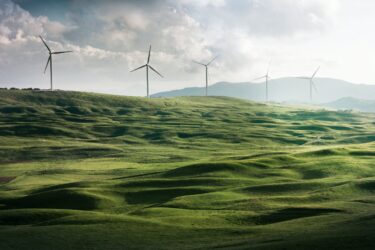Blog | 04 Sep 2024
It’s a bumpy road but Australia’s 2030 climate target is within sight

Kristian Kolding
Head of Consulting, OE Australia

Summary
Greenhouse gas emissions in Australia are estimated to be 30% lower than they were in 2005. Our baseline forecast suggests we’re broadly on track to hit our 2030 climate target to reduce emissions by a further 13%. That said, the green transition is proving to be an uncertain and bumpy road.
There are plausible and relevant futures where the green transition is achieved ahead of schedule and temperatures increases remain well below 2 degrees, but there are also significant risks of delays which results in a significant warmer and more volatile environment in years to come. With this in mind, we applaud the recent amendment to the Australian Sustainability Reporting Standards to require businesses to describe the transition risks and opportunities for their business in a net zero future as well as the physical challenges associated with a warmer and more volatile scenario.
We’re on track to hit our 2030 targets but net zero remains aspirational.
Carbon conscious land use and renewable electricity is set to drive the green transition to 2030. But that’s when the hard work begins. The path to decarbonising transport and industry remains shrouded in uncertainty. That’s ok for now, but clarity will be required sooner rather than later to set a credible 2035 emission target and create an equitable and manageable transition to net zero by 2050.
Success over the next ten years will depend on the green electricity transition. The success of the first Capacity Investment Scheme auction, finalisation of the Victorian offshore wind power auction and AEMO’s updated Integrated Systems Plan have provided important planning clarity and support for the transition in the last six months.
Chart 1: Australia’s Greenhouse Gas Emissions Outlook
Source: DCCEEW, Oxford Economics Australia
The extent of the support provided gives a good sense of the challenges faced. Development approval delays, construction delays and cost increases are all proving to be very real and practical challenges to the energy transition. Add in the uncertainty sowed by the Coalition’s nuclear energy statements and you get a wide set of plausible forecast outcomes, with the current risks weighted towards higher levels of emissions than currently forecast.
Agriculture, forestry and land use change – the unsung hero
Walking the analysis back to 2005 we see that the vast majority of our success comes from change to our use of land to become significantly more environmentally conscious. More specifically, of the 181 Mt reduction in annual emissions since 2005, approximately 167Mt has been contributed by more carbon conscious land use. Once we strip this out – we see that decarbonization achieved by reducing our industrial and household use of energy is negligible since 2005.
Chart 2: A historical analysis of Australia’s greenhouse gas emissions
The baseline forecast – the mother of all scenarios
Economists have created ‘what if’ scenarios to assess the potential impact of climate change for decades. As a matter of fact, the UN IPCC collected more than 3,000 scenarios for the Sixth Assessment Report. Despite the proliferation of ‘what if’ scenarios, very few economists actually forecast the most likely future of climate emissions and its impact on the economy on a regular basis. This is what we refer to as our baseline forecast.
Our baseline forecast is based on current climate change policies implemented in Australia, an expectation that technology will continue to advance at a similar rate as we’ve seen over the last couple of decades, and the size and shape of the Australian economy in the future.
Our climate analysis is deeply integrated into our broader analysis of the Australian and global economy. The global link is important to capture the implications of the global transition to net zero and how that affects Australia’s export opportunities. The link between emissions and the rest of the economy is essential to assess the implications of climate change on factors such as employment, cost of living and investment opportunities.
Our baseline view will continually evolve as the climate transition and the economy evolves. The purpose of the baseline is to inform decision makers about the expected impact of the current emission trajectory and whether we need to do more or less to meet our targets. What’s more, the baseline can help inform what must be done to meet our targets, and what the cost of doing so will be on the broader economy.
Your Author

Kristian Kolding
Head of Consulting, OE Australia
+61 (4) 1040 9070

Kristian Kolding
Head of Consulting, OE Australia
Sydney, Australia
Kristian leads Oxford Economics Australia’s Consulting team, working with public and private sector leaders to help them prepare for the future by applying relevant economic theory and forecasts to inform effective policy and business strategy development.
More Research

Post
Global Economic Prospects and Risks – Where will we find growth?
Adrian Cooper set out the key factors that will drive the economic outlook for 2024 and beyond, including how long the current economic slowdown is likely to last, how quickly underlying inflationary pressures will ease, and the implications for interest rates and financial markets.
Find Out More
Post
Taking stock of Australia’s journey to net zero. Where are we at, what’s to come, how do we get there?
We’ve taken stock of Australia’s journey towards net zero and the good news is that emissions are dropping. The bad news is that emissions aren’t dropping fast enough.
Find Out More
Post
Is the New Vehicle Efficiency Standards too much of a good thing?
Proposing to introduce a New Vehicle Efficiency Standard can hardly be a bad thing – particularly when you're the last developed country except for Russia to do so
Find Out More
Post
Op-ed: Is the New Vehicle Efficiency Standards too much of a good thing?
Kristian Kolding from Oxford Economics Australia analyses the New Vehicle Efficiency Standard in the op-ed in The Australian Financial Review,
Find Out More
Post
Australia’s Safeguard Mechanism to complement CBAM
In October 2023, the CBAM entered its first transitional phase, requiring EU importers to start reporting on their emissions. The CBAM will come into full force in 2026, when importers will be required to purchase and surrender CBAM certificates.
Find Out More
Post
Can we walk the talk as we approach our 2030 climate goals?
As the world heats up, so does the urgency to assess our collective progress against the goal of limiting global temperature increases to 2℃ as set out in the Paris Agreement.
Find Out More